1995 CADILLAC SEVILLE coolant level
[x] Cancel search: coolant levelPage 162 of 410
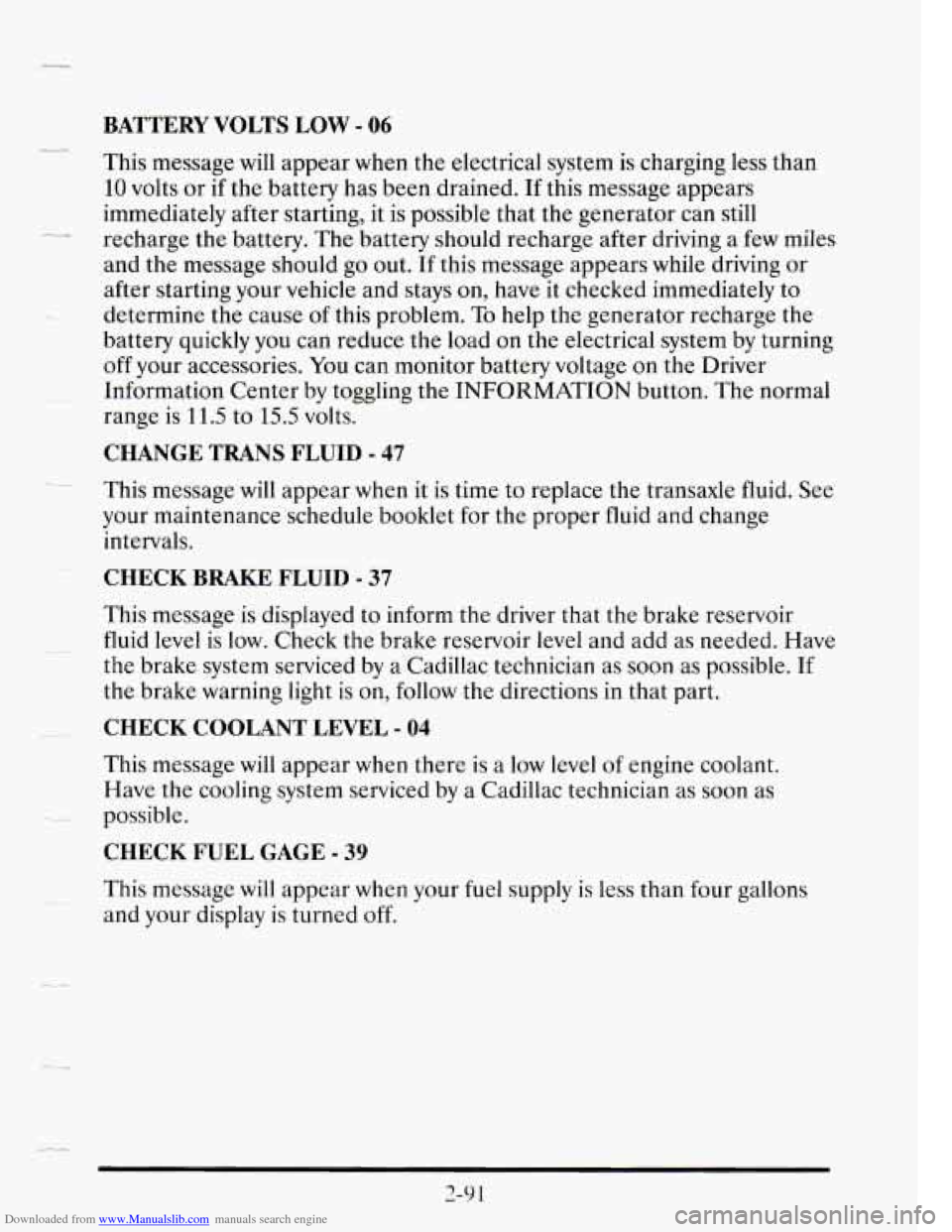
Downloaded from www.Manualslib.com manuals search engine BATTERY VOLTS LOW - 06
_L-.
This message will appear when the electrical system is charging less than
10 volts or if the battery has been drained. If this message appears
immediately after starting, it is possible that the generator can still
recharge the battery. The battery should recharge after driving a few miles
and the message should go out.
If this message appears while driving or
after starting your vehicle and stays on, have it checked immediately to
-~ determine the cause of this problem. To help the generator recharge the
battery quickly you can reduce the load on the electrical system by turning
off your accessories. You can monitor battery voltage on the Driver
Information Center by toggling the INFORMATION button. The normal
range is
11.5 to 15.5 volts.
-
CHANGE TRANS FLUID - 47
~- This message will appear when it is time to replace the transaxle fluid. See
your maintenance schedule booklet
for the proper fluid and change
intervals.
CHECK BRAKE FLUID - 37
This message is displayed to inform the driver that the brake reservoir
fluid level
is low. Check the brake reservoir level and add as needed. Have
the brake system serviced by
a Cadillac technician as soon as possible. If
the brake warning light is on, follow the directions in that part.
CHECK COOLANT LEVEL - 04
This message will appear when there is a low level of engine coolant.
Have the cooling system serviced by a Cadillac technician
as soon as
possible.
CHECK FUEL GAGE - 39
This message will appear when your fuel supply is less than four gallons
and your display
is turned off.
Page 163 of 410
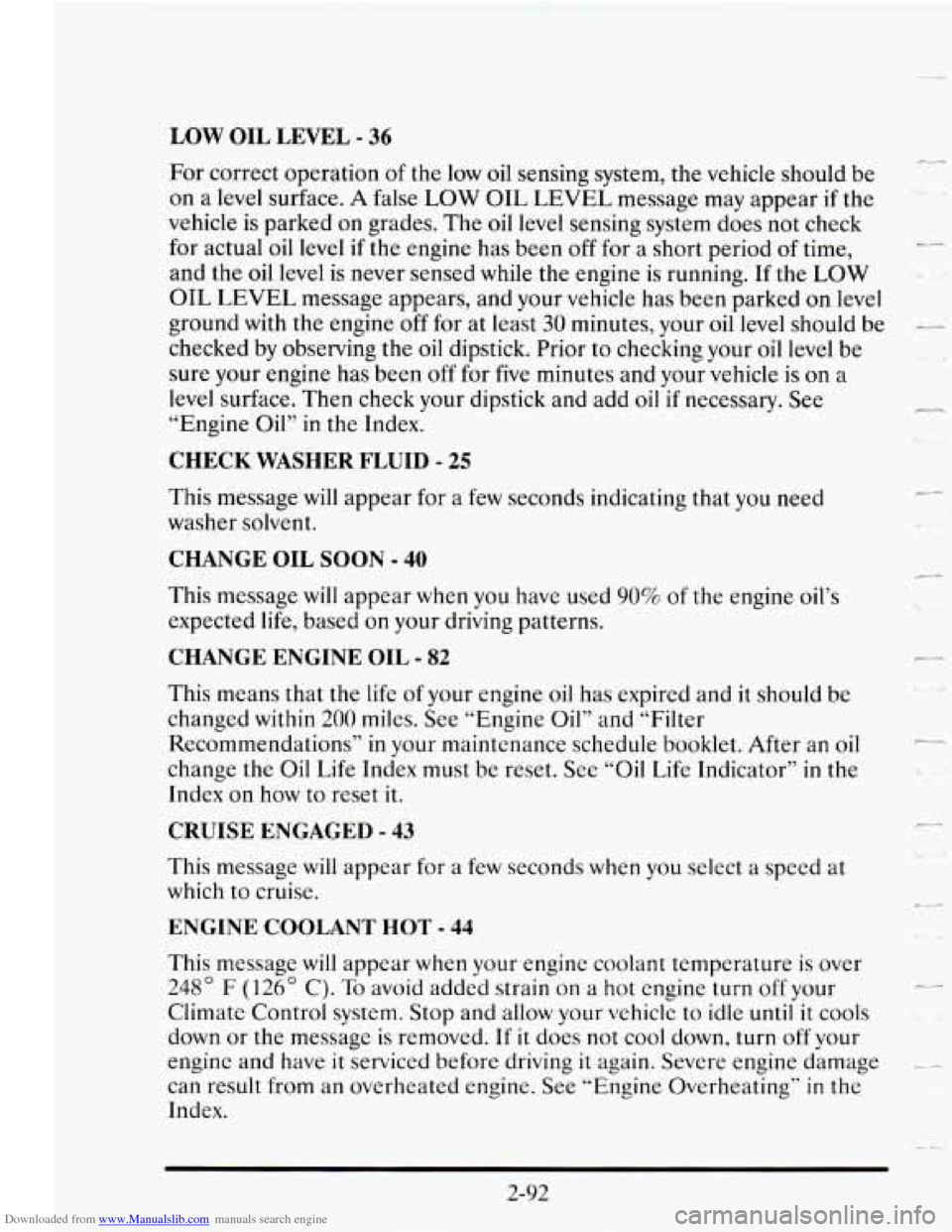
Downloaded from www.Manualslib.com manuals search engine LOW OIL LEVEL - 36
For correct operation of the low oil sensing system, the vehicle should be
on a level surface.
A false LOW OIL LEVEL message may appear if the
vehicle is parked
on grades. The oil level sensing system does not check
for actual oil level
if the engine has been off for a short period of time,
and the
oil level is never sensed while the engine is running. If the LOW
OIL LEVEL message appears, and your vehicle has been parked on level
ground with the engine
off for at least 30 minutes, your oil level should be -
checked by observing the oil dipstick. Prior to checking your oil level be
sure your engine has been
off for five minutes and your vehicle is on a
level surface. Then check
your dipstick and add oil if necessary. See
“Engine Oil”
in the Index.
CHECK WASHER FLUID - 25
This message will appear for a few seconds indicating that you need
washer solvent.
CHANGE OIL SOON - 40
This message will appear when you have used 90% of the engine oil’s
expected life, based on your driving patterns.
CHANGE ENGINE OIL - 82
This means that the life of your engine oil has expired and it should be
changed
within 200 miles. See “Engine Oil” and “Filter
Recommendations” in your maintenance schedule booklet. After an
oil
change the Oil Life Index must be reset. See “Oil Life Indicator” in the
Index on how to reset it.
CRUISE ENGAGED - 43
This message will appear for a few seconds when you select a speed at
which to cruise.
ENGINE COOLANT HOT - 44
This message will appear when your engine coolant temperature is over
248” F (126O C). To avoid added strain on a hot engine turn off your
Climate Control system. Stop and allow your vehicle to idle
until it cools
down or the message is removed.
If it does not cool down, turn off your
engine and have
it serviced before driving it again. Severe engine damage
can result from an overheated engine. See “Engine Overheating”
in the
Index.
Y-
2-92
Page 164 of 410
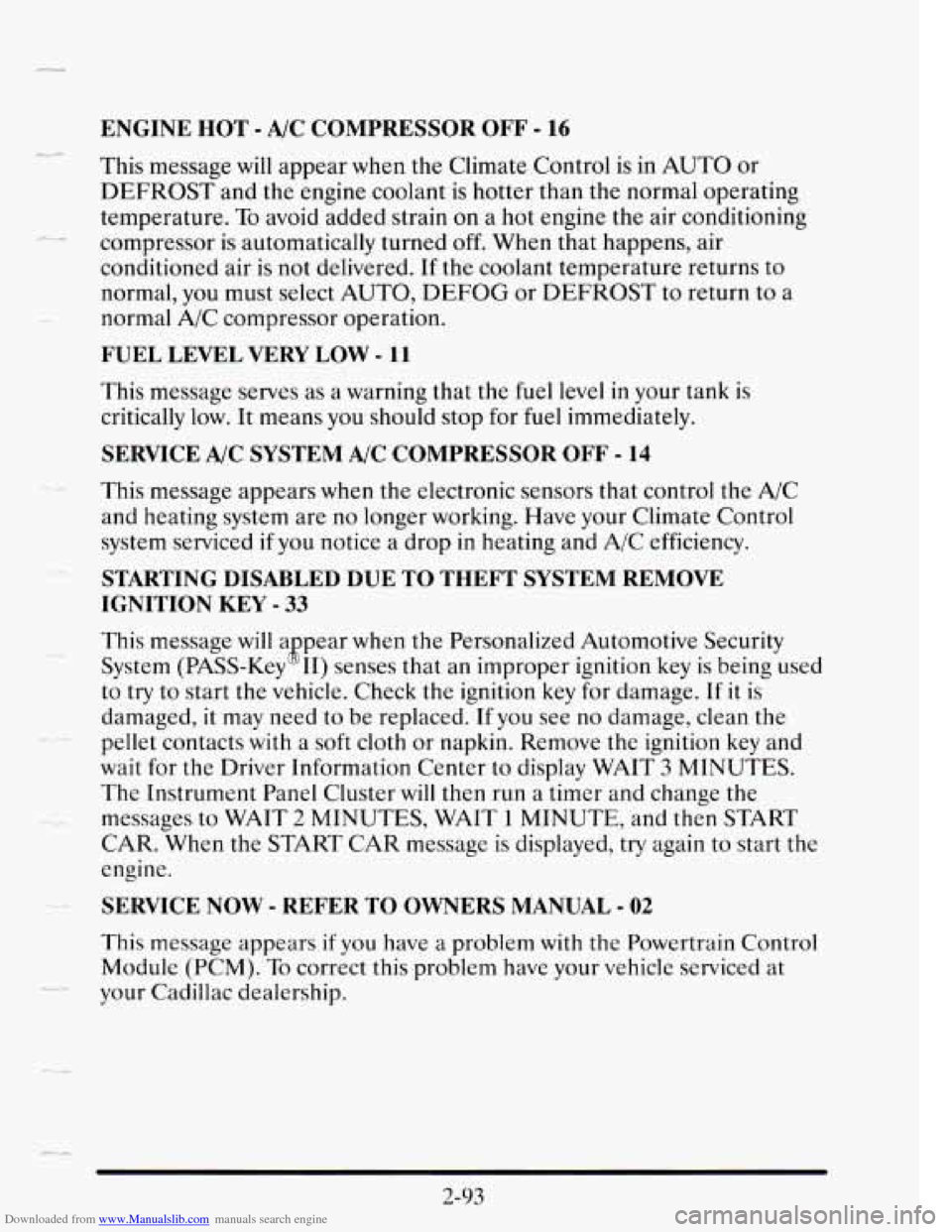
Downloaded from www.Manualslib.com manuals search engine ENGINE HOT - A/C COMPRESSOR OFF - 16
-_ ..
This message will appear when the Climate Control is in AUTO or
DEFROST and the engine coolant is hotter than the normal operating
temperature. To avoid added strain on a hot engine the air conditioning
compressor is automatically turned off. When that happens, air
conditioned air is not delivered.
If the coolant temperature returns to
normal, you must select AUTO,
DEFOG or DEFROST to return to a
normal A/C compressor operation.
I_ -
FUEL LEVEL VERY LOW - 11
This message serves as a warning that the fuel level in your tank is
critically low. It means you should stop for fuel immediately.
SERVICE A/C SYSTEM A/C COMPRESSOR OFF - 14
- This message appears when the electronic sensors that control the A/C
and heating system are
no longer working. Have your Climate Control
system serviced
if you notice a drop in heating and A/C efficiency.
STARTING DISABLED DUE TO THEFT SYSTEM REMOVE
IGNITION
KEY - 33
This message will a pear when the Personalized Automotive Security
System (PASS-Key
8 11) senses that an improper ignition key is being used
to
try to start the vehicle. Check the ignition key for damage. If it is
damaged,
it may need to be replaced. If you see no damage, clean the
~ pellet contacts with a soft cloth or napkin. Remove the ignition key and
wait for the Driver Information Center
to display WAIT 3 MINUTES.
The Instrument Panel Cluster
will then run a timer and change the
messages to WAIT
2 MINUTES, WAIT 1 MINUTE, and then START
CAR. When the START CAR message is displayed,
try again to start the
engine.
SERVICE NOW - REFER TO OWNERS MANUAL - 02
This message appears if you have a problem with the Powertrain Control
Module (PCM). To correct this problem have your vehicle serviced at
your Cadillac dealership.
---
2-93
Page 173 of 410
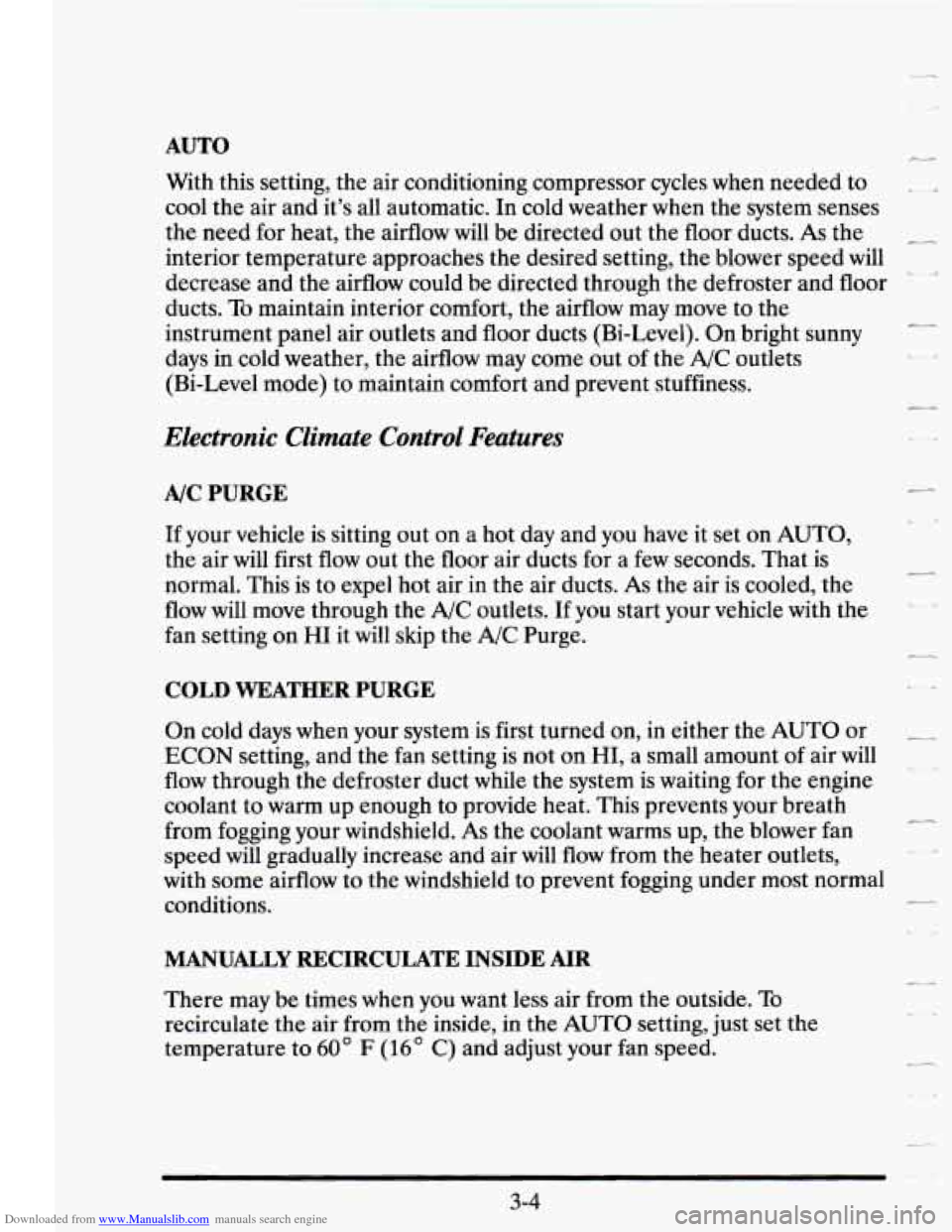
Downloaded from www.Manualslib.com manuals search engine AUTO
With this setting, the air conditioning compressor cycles when needed to
cool the air and it's all automatic. In cold weather when the system senses
the need
for heat, the airflow will be directed out the floor ducts. As the r--T
interior temperature approaches the desired setting, the blower speed will
decrease and the airflow could be directed through the defroster and floor
ducts.
To maintain interior comfort, the airflow may move to the
instrument panel air outlets and floor ducts (Bi-Level).
On bright sunny
days in cold weather, the airflow may come out
of the A/C outlets
(Bi-Level mode) to maintain comfort and prevent stuffiness.
Electronic Climate Control Features
A/C PURGE
If your vehicle is sitting out on a hot day and you have it set on AUTO,
the air will first
flow out the floor air ducts for a few seconds. That is
normal. This is to expel hot air in the air ducts.
As the air is cooled, the
flow will move through the
A/C outlets. If you start your vehicle with the
fan setting on HI it will skip the
A/C Purge.
COLD WEATHER PURGE
-.
On cold days when your system is first turned on, in either the AUTO or
ECON setting, and the fan setting is not on HI, a small amount of air will
flow through the defroster duct while the system is waiting for the engine
coolant to warm up enough to provide heat. This prevents your breath
from fogging your windshield. As the coolant warms up, the blower fan
speed will gradually increase and air will flow from the heater outlets, .. 3
with some airflow to the windshield to prevent fogging under most normal
conditions.
MANUALLY RECIRCULATE INSIDE AIR
There may be times when you want less air from the outside. To
recirculate the air from the inside, in the AUTO setting, just set the
temperature to
60" F (16O C) and adjust your fan speed.
-.
3-4
Page 255 of 410
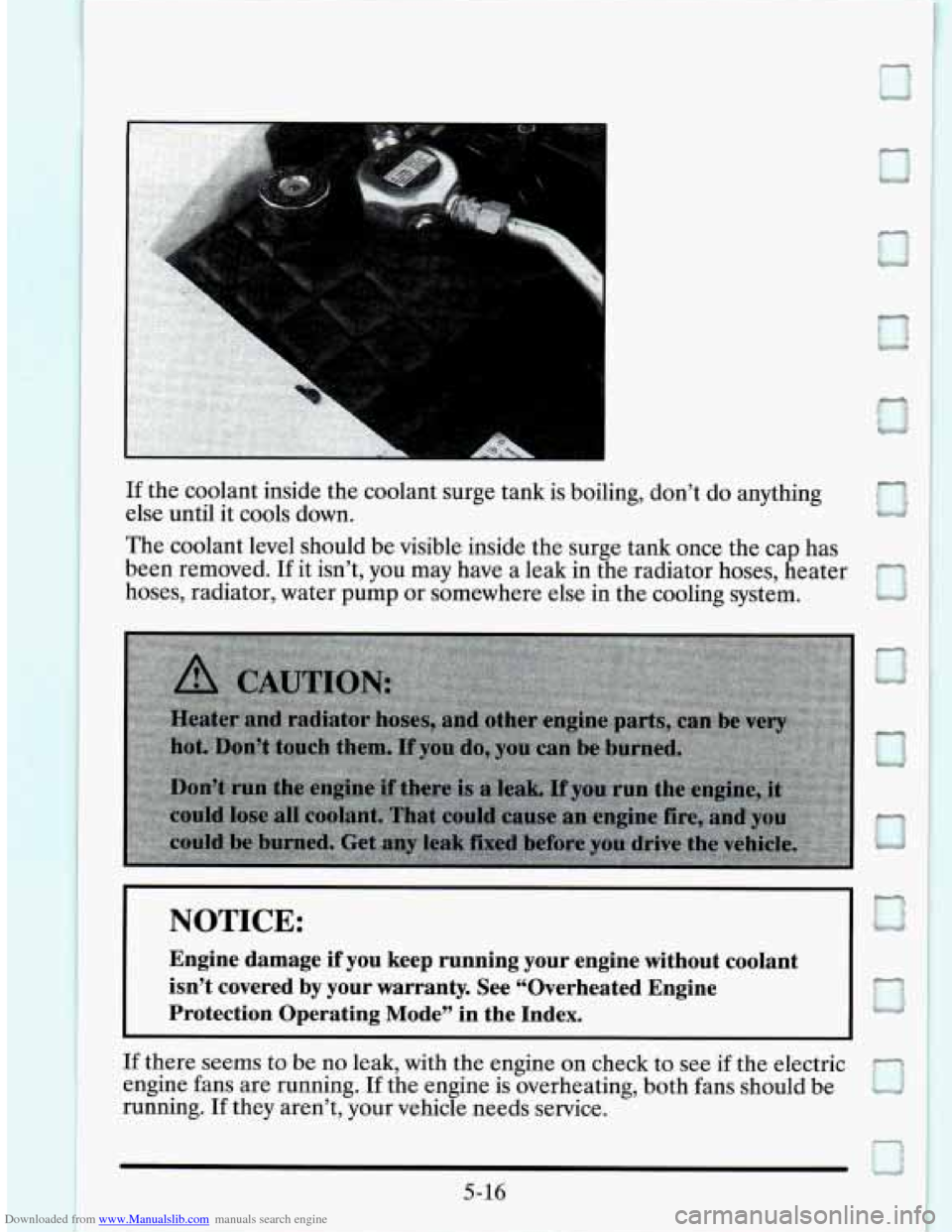
Downloaded from www.Manualslib.com manuals search engine 13
a
If the coolant inside the coolant surge tank is boiling, don’t do anything
else until it cools down.
The coolant level should be visible inside the surge tank once the cap has
been removed.
If it isn’t, you may have a leak in the radiator hoses, heater
hoses, radiator, water pump or somewhere else in the cooling system.
a
I NOTICE: I R
Engine damage if you keep running your engine without coolant
isn’t covered
by your warranty. See “Overheated Engine
Protection Operating Mode” in
the Index.
If there seems to be no leak, with the engine on check to see if the electric
engine fans are running.
If the engine is overheating, both fans should be
running. If they aren’t, your vehicle needs service.
a
5- 16
Page 256 of 410
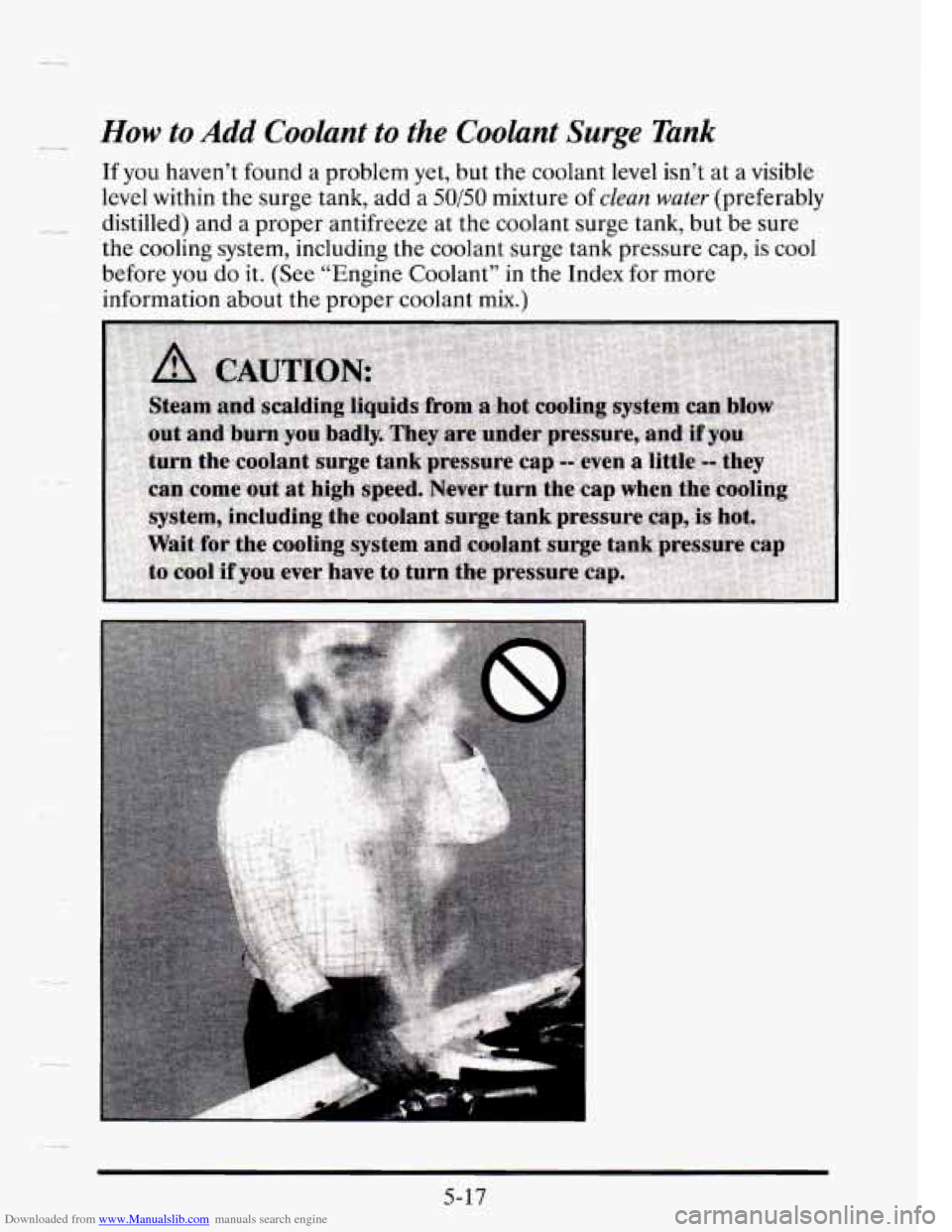
Downloaded from www.Manualslib.com manuals search engine -- How to Add Coolant to the Coolant Surge Tank
If you haven’t found a problem yet, but the coolant level isn’t at a visible
level within the surge tank, add
a 50/50 mixture of clean water (preferably
the cooling system, including the coolant surge tank pressure cap,
is cool
before
you do it. (See “Engine Coolant” in the Index for more
information about the proper coolant
mix.)
- distilled) and a proper antifreeze at the coolant surge tank, but be sure
5-17
Page 259 of 410
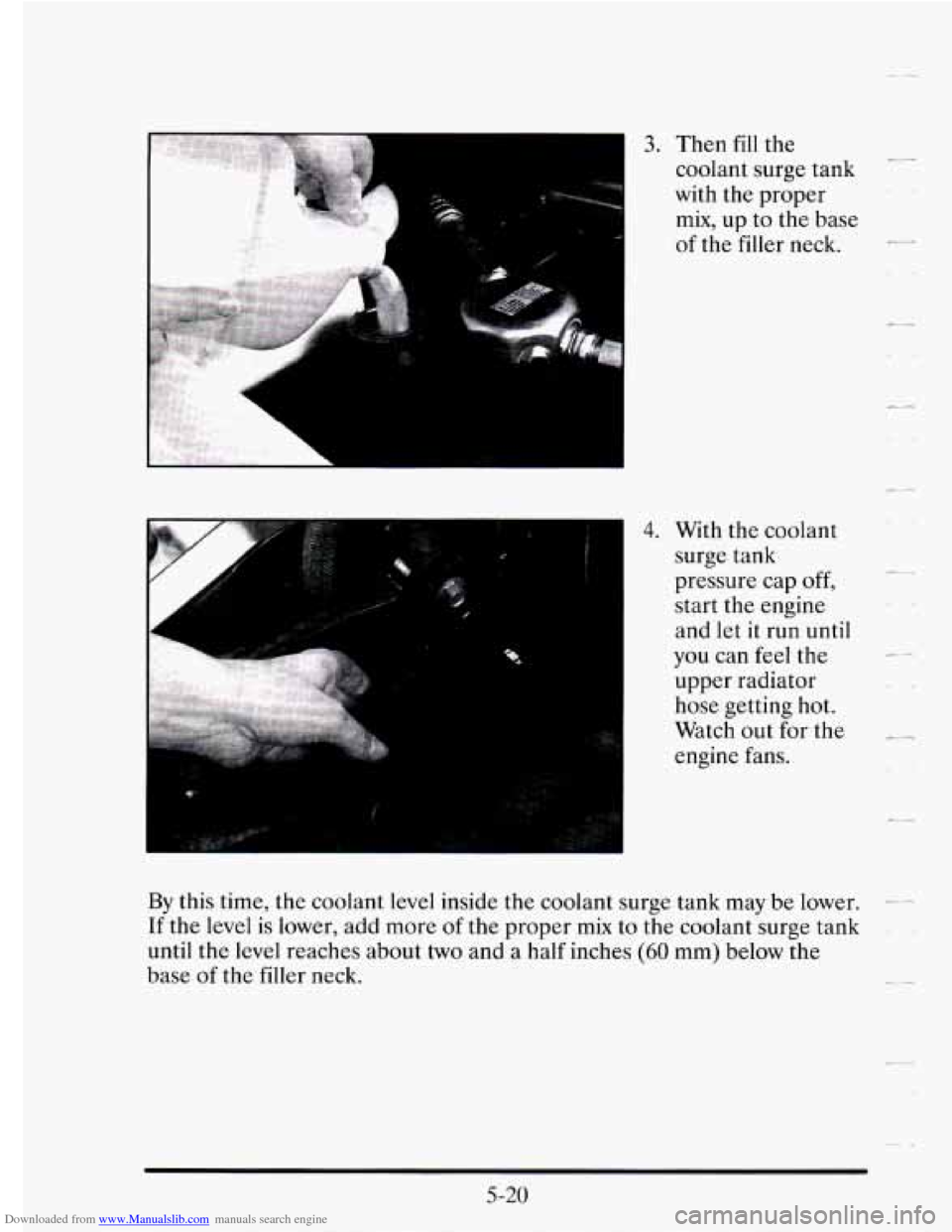
Downloaded from www.Manualslib.com manuals search engine I 3. Then fill the p_ coolant surge tank
with
the proper
mix, up to the base
of the filler neck.
Zd
- 4. With the coolant
surge tank
pressure cap off,
start
the engine
and
let it run until
you can feel the
upper radiator
hose getting
hot.
Watch out for the
engine fans.
By this time, the coolant level inside the coolant surge tank may be lower. --
If the level is lower, add more of the proper mix to the coolant surge tank
until the level reaches about
two and a half inches (60 mm) below the
base
of the filler neck.
5-20
Page 260 of 410
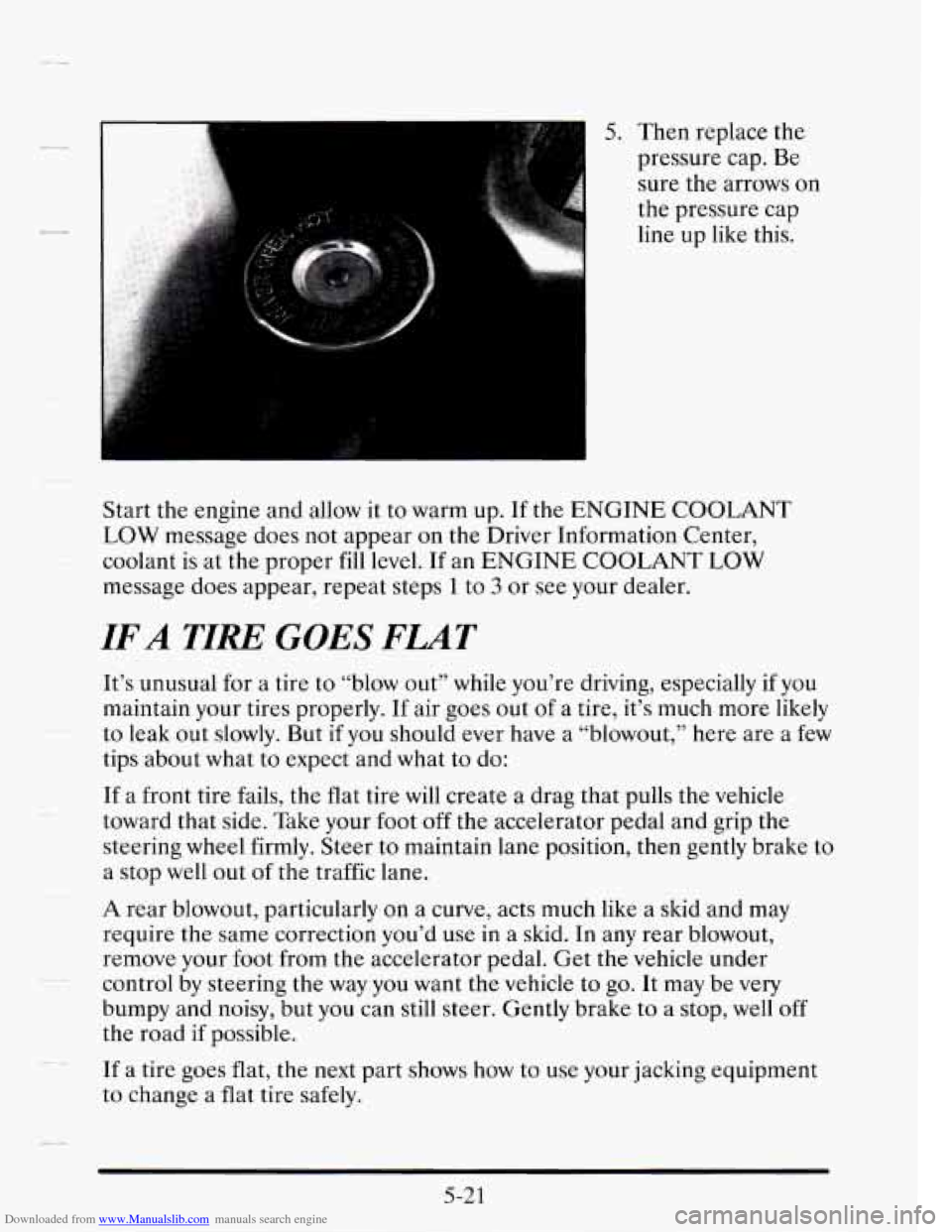
Downloaded from www.Manualslib.com manuals search engine 5. Then replace the
pressure
cap. Be
sure the arrows on
the pressure cap
line up
like this.
Start the engine and allow
it to warm up. If the ENGINE COOLANT
LOW message does not appear on the Driver Information Center,
coolant
is at the proper fill level. If an ENGINE COOLANT LOW
message does appear, repeat steps 1 to 3 or see your dealer.
IFA TIRE GOES FLAT
It’s unusual for a tire to “blow out” while you’re driving, especially if you
maintain your tires properly.
If air goes out of a tire, it’s much more likely
to leak out slowly. But if you should ever have a “blowout,” here are a few
tips about
what to expect and what to do:
If a front tire fails, the flat tire
will create a drag that pulls the vehicle
toward that side. Take your foot off the accelerator pedal and grip the
steering wheel firmly. Steer to maintain lane position, then gently brake to
a stop well out of the traffic lane.
A rear blowout, particularly on a curve, acts much like a skid and may
require the same correction you’d use in a skid. In any rear blowout,
remove your foot from the accelerator pedal. Get the vehicle under
control by steering the way you want the vehicle
to go. It may be very
bumpy and noisy, but you can still steer. Gently brake to a stop, well off
the road
if possible.
If
a tire goes flat, the next part shows how to use your jacking equipment
to change a flat tire safely.
5-2 1